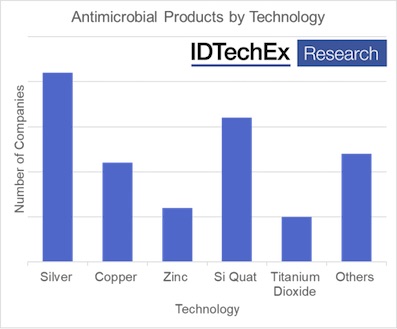 Cleanzine: your weekly cleaning and hygiene industry newsletter 26th June 2025 Issue no. 1168
Cleanzine: your weekly cleaning and hygiene industry newsletter 26th June 2025 Issue no. 1168
Your industry news - first
The original and best - for over 20 years!
We strongly recommend viewing Cleanzine full size in your web browser. Click our masthead above to visit our website version.
Innovations in antimicrobials: IDTechEx report highlights start-ups developing new methods to eliminate microbes
 Antimicrobial technologies are used around the world in response to the pandemic, since surfaces and products protected by antimicrobial technology can continuously inactivate and kill harmful microorganisms such as the SARS-CoV-2 virus.
Antimicrobial technologies are used around the world in response to the pandemic, since surfaces and products protected by antimicrobial technology can continuously inactivate and kill harmful microorganisms such as the SARS-CoV-2 virus.
IDTechEx has recently published a research report covering the antimicrobial market, examining the technologies, innovations, and opportunities.
In this article, IDTechEx highlights three innovative start-ups that are developing next-generation antimicrobial technologies…
Applied Silver - Renewing antimicrobial textiles with each wash:
Founded in 2012, Applied Silver is a US-based start-up that focuses on preventing the spread of infections through soft surfaces. The company has developed the SilvaClean platform technology, an EPA-approved water-based ionic silver additive for textiles. SilvaClean renders textiles antimicrobial through a smart micro-dosing system that attaches to commercial washing machines and dispenses silver ions during the laundry rinse cycle. Applied Silver has demonstrated through surveillance studies in three hospitals that its technology can decrease the rate of healthcare-associated infections by 43% when incorporated as a part of the hospital's infection prevention program.
The Innovation:
Textiles are typically embedded or coated with antimicrobial additives during the manufacturing process. As such, their antimicrobial content decreases with each wash. Antimicrobial textiles can last for 50-100 washes, usually fewer. In contrast, Applied Silver's SilvaClean renews the antimicrobial silver ions every time the textile is washed.
Parx Materials - Inhibiting biofilm formation through anti-adhesion:
Parx Materials is a Dutch and Italian start-up that has commercialised a zinc-based antimicrobial technology. Unlike most other zinc-based technologies, Parx Materials does not use zinc pyritihone, but rather, ionic zinc. Another aspect that sets Parx Materials apart is that its technology does not rely on zinc ions entering the microorganisms; plastics incorporating Parx Material's masterbatch are antimicrobial through the prevention of adhesion. For bacteria, adhesion is the first step of biofilm formation, and in nutrient-poor environments such as hard surfaces, is required to stimulate growth. However, after 3-4 hours of being on a Parx Materials surface, the planktonic bacteria simply reach the end of their life.
The Innovation:
Most antimicrobial products on the market today rely on microorganisms taking in toxic metal ions. However, this places pressure on microorganisms to develop mechanisms to pump out the ions; mechanisms which can also be used to pump out antibiotics. An antimicrobial technology that is effective through non-interaction decreases the risk of forming antibiotic-resistant bacteria.
Dyphox - Non-toxic components create a highly effective product:
Dyphox is a German start-up, founded in 2010 as a project with the University Hospital in Regensburg. The goal of the project was to develop an antimicrobial technology that has an impact in a real-life setting, avoids generating antibiotic-resistant microorganisms, and is safe for the environment. Dyphox has modified spice and plant ingredients to identify photocatalysts that absorb light in the visible range and generate singlet oxygen with high efficacy. Dypox has tested its product (also called Dyphox) in two hospitals in Germany - the coating maintained high effectiveness in keeping bioburden low even after nine months.
The Innovation:
Individually, Dyphox's three components of light, dye, and oxygen are harmless. Singlet oxygen is very unlikely to induce resistance and is less reactive than other reactive oxygen species, which may damage the underlying material. Unlike other photocatalytic antimicrobial technologies, Dyphox does not require UV light for activation.
IDTechEx's latest report on the topic, ‘Antimicrobial Technology Market 2021-2031’, analysed over 100 companies in the antimicrobial technology market, including innovative start-ups such as those described in this article. For more information on this report, visit:
11th March 2021







